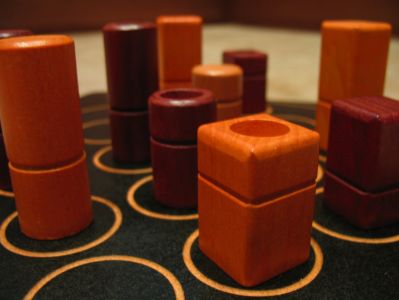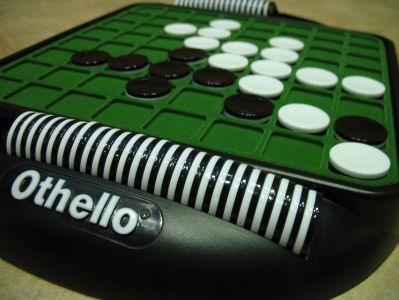
In the third and final part of our summer series on thinking games, we look at three strategy games that are deceptively simple. We use these games at IMACS to sharpen the critical thinking skills of our students. While chess is rightfully considered by many as the ultimate strategy game, we like the three games below because the simple rules are very easy to learn, even for someone as young as five or six, and each game does not take an eternity to play. Best of all, each is kid-tested and IMACS-approved!
Quoridor by Gigamic

Game Essentials: Quoridor is a fantastic game of strategy, especially for those who like mazes. In the typical two-player setup, the pawns are placed on the middle squares of opposite sides of a 9×9 board. The winner is the first to maneuver her pawn from its starting position to any of the nine squares on her opponent’s side. Generally speaking, you can move one square at a time, forward or backward or left or right but usually not diagonally. You can also jump over your opponent’s pawn when the two pawns are face to face. Seems trivial so far, right? That’s because we haven’t yet discussed the fences! You see, at each turn, a player can choose to either move her pawn or to impede her opponent by putting up a fence that blocks or lengthens the opponent’s path. Twenty fences are divided evenly at the start of the game, and the main rule governing them is that you can’t use them to block all possible paths – there must be at least one way to get from one side of the board to the other. The video below from Gigamic illustrates these rules:
For brevity’s sake, the video showed a short and simple game. But, in fact, games are typically much more complex. With each fence placed on the board, an increasingly complicated maze of paths from one side to the other is built. And the results can be downright maddening! One minute, you think you’re making good progress only to have your pathway dead-ended by your opponent, in which case you have to backtrack, costing precious moves. Another time, you may turn the tables on your opponent by blocking him only to be obstructed by your own fence placement later in the game.
As with most abstract strategy games, winning depends on your ability to think ahead about the possible outcomes of available moves and select the optimal path. In other words, to take your strategy beyond simply “move forward – block opponent,” you must build and analyze a decision tree in your mind. You also need to think offensively and defensively at all times. For example, if you are progressing alongside a series of fences, your opponent will almost certainly use a new fence to block you just as you get to an opening. However, if you use one of your fences to block the path behind your pawn, then your opponent may not be allowed to block your way forward if it would close off all paths. Still, you must be careful to use your fences judiciously so that you don’t run out of them too soon.
Quoridor may also be played with three or four players. Each player selects one of the four sides of the board as the side for his pawn’s starting position and works toward being the first to reach the opposite side. Divide the fences up so that each player has an equal number with as few left over as possible. Then just follow the rules of movement and fence placement from the two-player game.
Recommended Age: The manufacturer suggests ages 6 and up, and we tend to agree. The rules of play are simple, but it does take a certain level of maturity to keep from getting frustrated when your opponent repeatedly blocks off your path.
Brain Play-To-Price Ratio: Quoridor lists for $29.99 but can be found for around $23. The rules and objective are easy for the youngest or most inexperienced players to learn, but mastering the game is a fun challenge that will engage children and adults alike for many years. As with most Gigamic board games, Quoridor is made of sturdy wood. And under Gigamic’s 10-year warranty, all you have to do to get free (love it!) replacement game pieces is send a letter to Gigamic.
Easier Adaptation: Gigamic makes a version called Quoridor Kid for ages 5 and up that costs about $5 less. The board is 7×7 instead of 9×9, and there are 16 fences instead of 20. The neutral-color game pieces and board are replaced by cute little mice, colorful fences and a cheerful board. Each mouse has a different colored nose which matches one of four colored cheese wedges on each side of the board. This nose-to-cheese match helps keep little ones focused on exactly which side of the game board they are aiming to reach. The smaller board typically means that a game of Quoridor Kid lasts a shorter amount of time. But the game rules are the same as Quoridor, and thus encourage the same kind of strategic thinking, albeit with a smaller number of paths to consider. The choice between starting with Quoridor Kid or going straight to Quoridor depends on whether you think your child would be more willing to stay engaged with the game due to the cute mouse-and-cheese theme. After all, you could just use the inner 7×7 section of “grown-up” board by ignoring the edge squares, as well as four of the fences.
Noteworthy: You can sample Quoridor online before deciding on a purchase. Just know that manipulating the fences online is not nearly as natural as when you’re holding the real thing in your hand.
Quarto by Gigamic

Game Essentials: Quarto is a two-player game that comes with 16 solid wood pieces and a sturdy 4×4 wooden board. All pieces not yet placed on the board are available to each player. The object of the game is simple: Be the first player to get four pieces that share a common feature in a line and call out “Quarto!” The line can be horizontal, vertical or diagonal, and you do not have to have placed all four pieces on the board yourself. So what are the possible common features? There are eight: a game piece can be light or dark, circular or square, short or tall, and hollow or solid. (A little elementary combinatorics confirms that we should, indeed, have 16 unique game pieces.) Here’s the kicker that makes Quarto stand out from other N-in-a-row games – you don’t pick the pieces that you place on the board; your opponent does! The following video illustrates these rules:
Quarto hones the mind’s ability to recognize patterns. This simple twist of picking out your opponent’s pieces comes with great responsibility for you must take care not to literally hand him the win. If you see that there is already a line with three circular pieces, then choose a square piece for him. If you’ve set yourself up to win with a short piece, then you might try to force your opponent to hand you one by giving him all the remaining tall pieces to play, assuming that such a move doesn’t give him the win.
As with games like tic-tac-toe or Connect Four, a primary strategy with Quarto is to set up more than one possible way to win so that if your opponent blocks one, you can still try to win with another. The ultimate two-pronged approach is to build two lines around two opposing features, e.g., one line of light pieces and another line of dark pieces. Then no matter what piece your opponent hands you next, you’re guaranteed a win because the piece you get, in this example, has to be either light or dark.
Recommended Age: The manufacturer suggests ages 6 and up, but a bright kindergartener should be able to enjoy this game. The rules are very simple. The only thing that takes getting used to is having your opponent choose the pieces that you place on the board instead of selecting them yourself.
Brain Play-To-Price Ratio: Like Quoridor, Quarto lists for $29.99 but can be found for around $23. If you want to experience either game for less, look for the travel editions. The craftsmanship is still excellent, but the smaller size will save you at least another $5. Quarto is fun for all ages, and Gigamic’s 10-year warranty and generous replacement policy applies to it as well.
Multipurpose: For small children, the wood pieces make for obvious fun as building and balancing blocks to hone fine motor skills. But you can also use them to introduce Venn diagrams. Just draw two large overlapping circles on a piece of paper and decide what characteristic each circle represents. For example, one circle can be tall pieces and the other circle can be hollow pieces. Ask your child to place each of the 16 pieces in the appropriate area of the paper. Change up what the circles represent and do it again. Add a new characteristic and expand to three overlapping circles. Not enough room on a sheet of paper? Get some yarn or raid the belts in Dad’s closet and make overlapping loops instead.
Easier Adaptation: With younger or less experienced players, you can simplify the objective by using just one, two or three of the four characteristics to make a winning line. For example, the first person to get four of the same color or four of the same shape in a line wins. Forget about height and hollowness until players feel ready to add on another level of difficulty.
Noteworthy: The Quarto rules also suggest a variation for advanced players that allows for nine more winning configurations. Specifically, in addition to getting four pieces in a line, you can win by getting four in a square. Just try keeping your eyes on all those possibilities!
Othello by Mattel

Othello, also known as reversi, is a widely-played classic game of strategy that has been around in some form since the late 1800’s. Its trademarked slogan sums it up beautifully: “A minute to learn, a lifetime to master!”™ With its simple rules, Othello can be played by children as young as five, even though the recommended age is eight to adult. If you’ve never had the pleasure of playing this game, watch the video explanation below:
Othello is an ideal game for teaching one of the key elements of strategy games, which is to think longer-term even if it means not choosing a move that seems optimal in the short-term. If you approach each turn with the goal of maximizing the number of disks of your color at the end of that one turn, then you will surely lose. Experienced players focus, instead, on setting up “helper” positions that will lead to the capture of certain prized locations on the board. These coveted spots (e.g., corners and edges) give a player tremendous leverage during the last series of moves that take place toward the end of a game.
Given the age and popularity of Othello, it should come as no surprise that its game strategies have been extensively researched, analyzed and documented. Here is a fairly readable strategy guide from the French Othello Federation. You can appreciate from this and other Othello guides that pattern recognition, another key element of strategy games, is an essential skill for winning.
Othello lists for $11.99, and will provide many hours of game play for the whole family. It’s also commonly available as a smartphone or tablet app and online. If you’d like to see some of the best Othello players in the world compete, you are somewhat in luck because the 35th Annual World Othello Championship will be held in the US this year.
If you are just discovering this blog, check out Part One of the series on logic games and Part Two on visual-spatial games. We hope that, through this series, you have discovered a new game or two to keep your brain active during these summer months and for years to come.
Make the right move with IMACS. Sign up for our free aptitude test. Play along with our weekly IMACS logic puzzles on Facebook.







